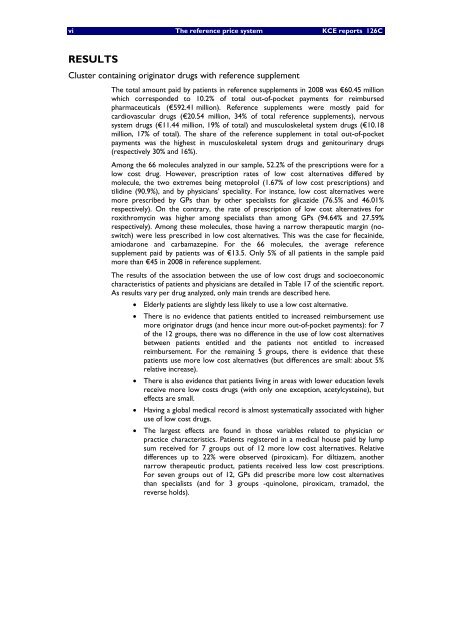The reference price system and socioeconomic differences in ... - KCE
The reference price system and socioeconomic differences in ... - KCE
The reference price system and socioeconomic differences in ... - KCE
You also want an ePaper? Increase the reach of your titles
YUMPU automatically turns print PDFs into web optimized ePapers that Google loves.
vi <strong>The</strong> <strong>reference</strong> <strong>price</strong> <strong>system</strong> <strong>KCE</strong> reports 126C<br />
RESULTS<br />
Cluster conta<strong>in</strong><strong>in</strong>g orig<strong>in</strong>ator drugs with <strong>reference</strong> supplement<br />
<strong>The</strong> total amount paid by patients <strong>in</strong> <strong>reference</strong> supplements <strong>in</strong> 2008 was €60.45 million<br />
which corresponded to 10.2% of total out-of-pocket payments for reimbursed<br />
pharmaceuticals (€592.41 million). Reference supplements were mostly paid for<br />
cardiovascular drugs (€20.54 million, 34% of total <strong>reference</strong> supplements), nervous<br />
<strong>system</strong> drugs (€11.44 million, 19% of total) <strong>and</strong> musculoskeletal <strong>system</strong> drugs (€10.18<br />
million, 17% of total). <strong>The</strong> share of the <strong>reference</strong> supplement <strong>in</strong> total out-of-pocket<br />
payments was the highest <strong>in</strong> musculoskeletal <strong>system</strong> drugs <strong>and</strong> genitour<strong>in</strong>ary drugs<br />
(respectively 30% <strong>and</strong> 16%).<br />
Among the 66 molecules analyzed <strong>in</strong> our sample, 52.2% of the prescriptions were for a<br />
low cost drug. However, prescription rates of low cost alternatives differed by<br />
molecule, the two extremes be<strong>in</strong>g metoprolol (1.67% of low cost prescriptions) <strong>and</strong><br />
tilid<strong>in</strong>e (90.9%), <strong>and</strong> by physicians’ speciality. For <strong>in</strong>stance, low cost alternatives were<br />
more prescribed by GPs than by other specialists for glicazide (76.5% <strong>and</strong> 46.01%<br />
respectively). On the contrary, the rate of prescription of low cost alternatives for<br />
roxithromyc<strong>in</strong> was higher among specialists than among GPs (94.64% <strong>and</strong> 27.59%<br />
respectively). Among these molecules, those hav<strong>in</strong>g a narrow therapeutic marg<strong>in</strong> (noswitch)<br />
were less prescribed <strong>in</strong> low cost alternatives. This was the case for fleca<strong>in</strong>ide,<br />
amiodarone <strong>and</strong> carbamazep<strong>in</strong>e. For the 66 molecules, the average <strong>reference</strong><br />
supplement paid by patients was of €13.5. Only 5% of all patients <strong>in</strong> the sample paid<br />
more than €45 <strong>in</strong> 2008 <strong>in</strong> <strong>reference</strong> supplement.<br />
<strong>The</strong> results of the association between the use of low cost drugs <strong>and</strong> <strong>socioeconomic</strong><br />
characteristics of patients <strong>and</strong> physicians are detailed <strong>in</strong> Table 17 of the scientific report.<br />
As results vary per drug analyzed, only ma<strong>in</strong> trends are described here.<br />
• Elderly patients are slightly less likely to use a low cost alternative.<br />
• <strong>The</strong>re is no evidence that patients entitled to <strong>in</strong>creased reimbursement use<br />
more orig<strong>in</strong>ator drugs (<strong>and</strong> hence <strong>in</strong>cur more out-of-pocket payments): for 7<br />
of the 12 groups, there was no difference <strong>in</strong> the use of low cost alternatives<br />
between patients entitled <strong>and</strong> the patients not entitled to <strong>in</strong>creased<br />
reimbursement. For the rema<strong>in</strong><strong>in</strong>g 5 groups, there is evidence that these<br />
patients use more low cost alternatives (but <strong>differences</strong> are small: about 5%<br />
relative <strong>in</strong>crease).<br />
• <strong>The</strong>re is also evidence that patients liv<strong>in</strong>g <strong>in</strong> areas with lower education levels<br />
receive more low costs drugs (with only one exception, acetylcyste<strong>in</strong>e), but<br />
effects are small.<br />
• Hav<strong>in</strong>g a global medical record is almost <strong>system</strong>atically associated with higher<br />
use of low cost drugs.<br />
• <strong>The</strong> largest effects are found <strong>in</strong> those variables related to physician or<br />
practice characteristics. Patients registered <strong>in</strong> a medical house paid by lump<br />
sum received for 7 groups out of 12 more low cost alternatives. Relative<br />
<strong>differences</strong> up to 22% were observed (piroxicam). For diltiazem, another<br />
narrow therapeutic product, patients received less low cost prescriptions.<br />
For seven groups out of 12, GPs did prescribe more low cost alternatives<br />
than specialists (<strong>and</strong> for 3 groups -qu<strong>in</strong>olone, piroxicam, tramadol, the<br />
reverse holds).
















